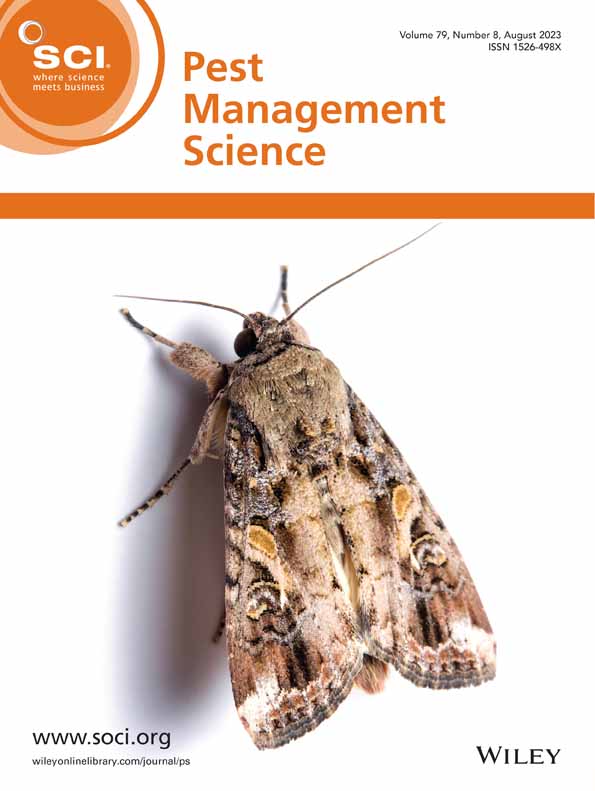View Item
- xmlui.general.dspace_homeCentros Regionales y EEAsCentro Regional Patagonia NorteEEA BarilocheArtículos científicosxmlui.ArtifactBrowser.ItemViewer.trail
- DSpace Home
- Centros Regionales y EEAs
- Centro Regional Patagonia Norte
- EEA Bariloche
- Artículos científicos
- View Item
Oviposition substrate location by the invasive woodwasp Sirex noctilio: the combined effect of chemical cues emitted by its obligate symbiont Amylostereum areolatum and different host-tree species
Abstract
BACKGROUND: Sirex noctilio is an invasive forest wasp that affects pines and can result in severe economic losses. The use of semiochemicals offers an opportunity to develop sensitive and specific capturing systems to mitigatenegative impacts. Previous research showed that female S. noctilio would use volatiles emitted by its fungal symbiont, Amylostereum areolatum, but little is known about how these modulate behaviour when combined with pine-wood
[ver mas...]
BACKGROUND: Sirex noctilio is an invasive forest wasp that affects pines and can result in severe economic losses. The use of semiochemicals offers an opportunity to develop sensitive and specific capturing systems to mitigatenegative impacts. Previous research showed that female S. noctilio would use volatiles emitted by its fungal symbiont, Amylostereum areolatum, but little is known about how these modulate behaviour when combined with pine-wood emissions. Our aim was to understand the relevance of fungal volatiles grown on artificial media and wood from two hosts trees, Pinus contorta and Pinus ponderosa, on behavioural and electroantennographic responses of wasp females. Because background odours can modify an insect´s response towards resource-indicating semiochemicals, we propose that the behaviour towards the symbiont (resource) will be modulated by host pine emissions (background odours).
RESULTS: Olfactometric assays showed that both host species with fungus were attractive when contrasted against air (P. contorta versus Air, χ2 = 12.19, P < 0.001; P. ponderosa versus Air, χ2 = 20.60, P < 0.001) and suggest a clear hierarchy in terms of female preferences towards the tested stimuli, with response highest towards the fungus grown on P. contorta (olfactory preference index: 5.5). Electrophysiological analyses indicate that females detect 62 volatile compounds from the tested sources.
CONCLUSION: Results indicate a strong synergy between symbiont and host semiochemicals, suggesting that the pine species could play a fundamental role in the interaction. Further understanding of the chemical basis of this, could guide the development of specific and attractive lures, in order to maximize attraction of wasps in surveillance programmes.
[Cerrar]

Author
Fuente
Pest Management Science : 1-39. (First published: 05 June 2023)
Date
2023-06
Editorial
Wiley
ISSN
1526-498X
1526-4998
1526-4998
Documentos Relacionados
Formato
pdf
Tipo de documento
artículo
Proyectos
(ver más)
INTA/2019-PE-E4-I074-001/2019-PE-E4-I074-001, Manejo Integrado de Plagas
INTA/2019-PD-E1-I600-001/2019-PD-E1-I600-001, Bioecología y estrategias de manejo de organismos perjudiciales y benéficos en escenarios de intensificación sustentable de cultivos
Palabras Claves
Derechos de acceso
Abierto
 Excepto donde se diga explicitamente, este item se publica bajo la siguiente descripción: Creative Commons Attribution-NonCommercial-ShareAlike 2.5 Unported (CC BY-NC-SA 2.5)
Excepto donde se diga explicitamente, este item se publica bajo la siguiente descripción: Creative Commons Attribution-NonCommercial-ShareAlike 2.5 Unported (CC BY-NC-SA 2.5)


